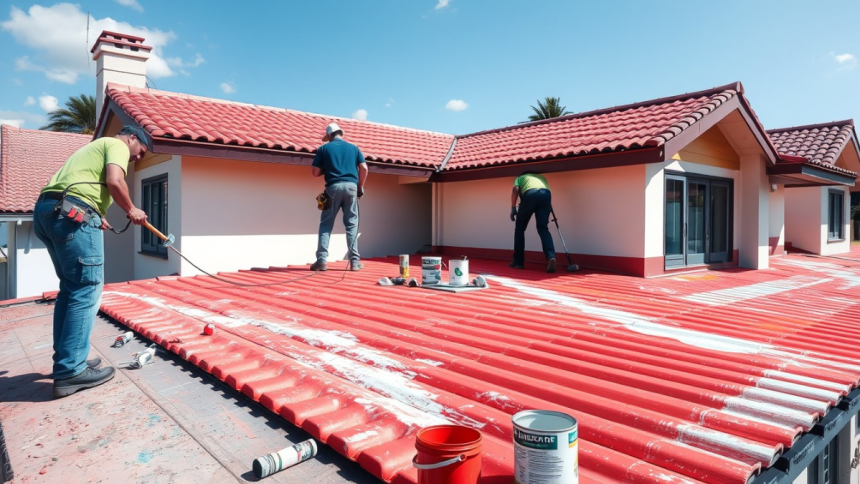Repainting or restoring a roofline might seem like a straightforward weekend project — until you’re standing metres off the ground, juggling paint tins, brushes, and your balance. It’s one of those jobs that looks manageable from the driveway, but quickly turns risky without the right setup.
That’s why experienced DIYers and professionals alike take safety seriously when working at height. One of the simplest ways to improve both stability and efficiency is by using a secure scaffold platform rather than relying on a ladder or makeshift supports. It’s not just about reaching high places — it’s about doing it with both hands free and both feet on something steady.
If you’re planning to tackle your roofline, fascia, or eaves, here’s how to do it the safe way from start to finish.
Understand the Risks of Working at Height
Painting or restoring your roofline means extended time off the ground — often at awkward angles or in exposed positions. The most common risks include:
- Losing balance while stretching or reaching
- Falling tools or paint from unstable surfaces
- Muscle strain from trying to hold yourself and your equipment steady
- Tripping over cords or paint gear mid-task
These risks aren’t just uncomfortable — they can lead to serious injury if not properly managed. That’s why safety starts before you even climb up.
Choose the Right Access Equipment
Many DIYers reach for the nearest ladder — but if your job involves more than a quick touch-up, that’s not the best call. A ladder doesn’t give you space to move or store tools, and even with someone spotting you, it can be limiting.
Here’s what to consider instead:
- Scaffold platforms for full access to the fascia, gutters, and eaves
- Adjustable mobile scaffolds for longer spans or uneven ground
- Wide work platforms that offer space for paint tins, rollers, and trays
These options allow you to move freely without repositioning every few minutes — reducing fatigue and increasing accuracy.
Always Work on Stable Ground
Before you start setting up, make sure the surface below is safe and secure:
- Avoid placing scaffolding or platforms on sloped driveways, loose soil, or gravel
- Use stabilisers or levelling jacks if the ground isn’t perfectly even
- Never prop up a structure with bricks or offcuts — it’s not worth the risk
If you’re unsure, a compact mobile scaffold with locking wheels can offer great flexibility while staying steady underfoot.
Don’t Skip the Prep Work
Prep is half the job — and often where corners are cut. For roofline work, this means:
- Clearing leaves and debris from the work area
- Checking the condition of the timber or render before you paint
- Ensuring no power lines or obstructions are nearby
- Wearing appropriate clothing and gear (like gloves and safety glasses)
Also, if you’re using cleaning chemicals or paint strippers, make sure your work zone is well-ventilated and that you’re wearing a proper mask or respirator.
Take Advantage of the Platform
One of the benefits of using a proper scaffold or platform is being able to keep everything within arm’s reach. This:
- Prevents overreaching (which often causes falls)
- Reduces repeated climbing up and down to get tools
- Keeps you focused and reduces fatigue
Use hooks or trays to hold rollers, scrapers, and rags — the small conveniences make a big difference when you’re metres in the air.
Know When to Stop
If the wind picks up, the sun becomes too harsh, or you start to feel dizzy or unsteady, pause the job. Working at height requires full focus and a steady hand. It’s better to finish another day than push through in unsafe conditions.
Also be aware of your body — painting above shoulder height for long periods can cause strain. Take regular breaks, hydrate, and stretch if needed.
Have a Second Person on Standby
Even if you’re confident on a scaffold, having someone nearby adds an extra layer of safety. They can:
- Pass tools or paint up to you
- Hold ladders or monitor scaffold movement
- Get help quickly in the unlikely event something goes wrong
It also makes the job feel a little less isolated — and you’ll finish faster with a second set of hands.
Working on your roofline can completely refresh the look of your home — but only if you can do it safely. With the right equipment, good planning, and a clear understanding of your limits, there’s no reason you can’t get professional-looking results on your own.
So take the extra time to prepare properly, set up safely, and give yourself room to work. When you’re standing confidently on a stable platform with everything you need in reach, the job becomes less about risk — and more about results.
Lynn Martelli is an editor at Readability. She received her MFA in Creative Writing from Antioch University and has worked as an editor for over 10 years. Lynn has edited a wide variety of books, including fiction, non-fiction, memoirs, and more. In her free time, Lynn enjoys reading, writing, and spending time with her family and friends.















